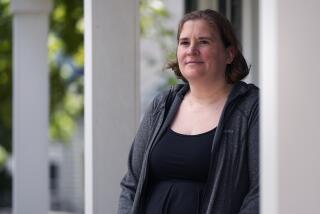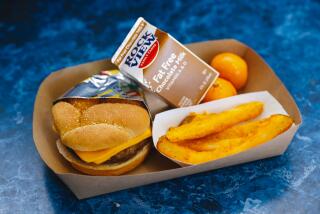In school cafeterias, a longer lunch is a more healthful lunch, study says

The more time kids have to eat lunch at school, the more fruits, vegetables and milk they consume, according to a new study.
- Share via
In the continuing quest to improve the health quotient of school lunches, experts have proposed fancy chefs, cutesy lunch boxes and smiley-faced stickers. Now comes a more straightforward suggestion – just make the lunch period longer.
The idea that schools could persuade kids to eat better without making a single change to their cafeteria menus may sound like pie in the sky, but its proponents have some data to back them up. After analyzing the eating habits of 1,001 elementary and middle school students in Boston-area schools, researchers found that the more time students had to finish their lunches, the more fruits and vegetables they ate and the more milk they drank.
One of the six schools that participated in the Modifying Eating and Lifestyles at School – or MEALS – study gave students as little as 20 minutes for lunch. Some of that time had to be spent getting to the cafeteria and standing in line when they got there. By the time they finally sat down with their trays, some kids had only 10 minutes to eat.
Of the other five schools in the study, two had a 25-minute lunch period and three set aside 30 minutes for the midday meal. The actual time to eat ranged from 10 minutes to 33 minutes (some teachers let their students go to lunch a little early), with an average eating time of 23.9 minutes.
The researchers, from Merrimack College in Massachusetts, the Harvard T.H. Chan School of Public Health and a Boston-based nonprofit called Project Bread, noticed two distinct trends.
First, the less time kids had to eat, the less likely they were to put fruit on their cafeteria trays. In schools where students had at least 25 minutes for lunch, 57% of kids chose a serving of fruit as part of their lunch. But when they had less than 20 minutes, only 44% selected fruit. Even kids with 20 to 24 minutes to eat opted for fruit only 47% of the time.
The study didn’t prove that short lunch periods caused kids to skip fruit, but the researchers said they doubted this was a coincidence. It’s likely that some of the students who were strapped for time went right by the fruit because they were “trying to rush through the lunch line to maximize their amount of time to eat,” they wrote. “It is also possible that these students recognized they would have less time to eat and therefore only selected foods they were likely to consume.”
The other obvious trend was that the longer kids sat at their lunch tables, the more food they consumed.
To figure this out, research assistants spied on kids when they left the lunch line, recording exactly what food they put on their trays and the exact time they headed to their tables. When the lunch period was over, the researchers collected the trays and weighed the food that was left.
Across the board, students prioritized eating their entrees. If they had at least 25 minutes to eat, they consumed 77% of their main dish, on average; if they had 20 to 24 minutes, they ate 70% of their entrees; and if they had less than 20 minutes, they finished 64% of their entrees.
However, more time in the cafeteria meant more time to round out the meal with healthful side dishes. The kids with the longest lunch periods ate 47% of their vegetables and drank 73% of their milk, on average. By comparison, the kids with the shortest lunches ate only 35% of their vegetables and drank only 62% of their milk, on average.
“A 30-minute lunch period would enable most students to have a sufficient amount of seated time in cafeterias, taking into account travel time to the cafeteria and waiting in line for food,” they wrote. If lunch periods can’t be lengthened, they added, schools could still maximize student eating time by adding more serving lines, implementing automated payment systems or taking other measures to make their cafeterias more efficient.
The findings were published Friday in the Journal of the Academy of Nutrition and Dietetics.
Follow me on Twitter @LATkarenkaplan and “like” Los Angeles Times Science & Health on Facebook.
ALSO
Scientists discover new human species relative: Homo naledi
Does another person’s skin feel softer than yours? It’s an illusion
The laziness imperative: Why zealous exercise burns fewer calories than we think







